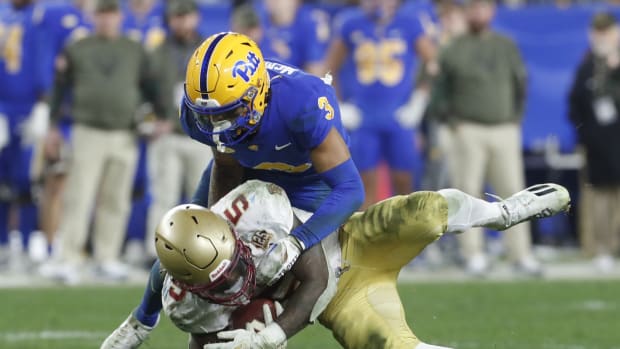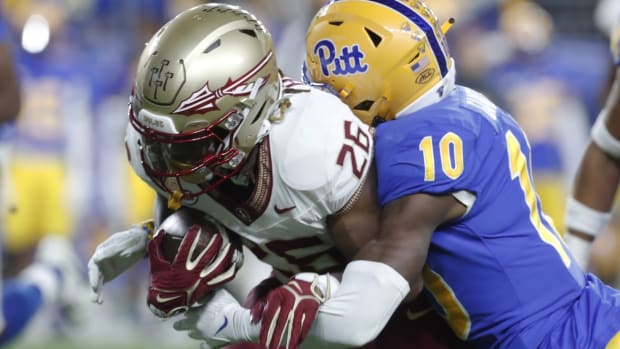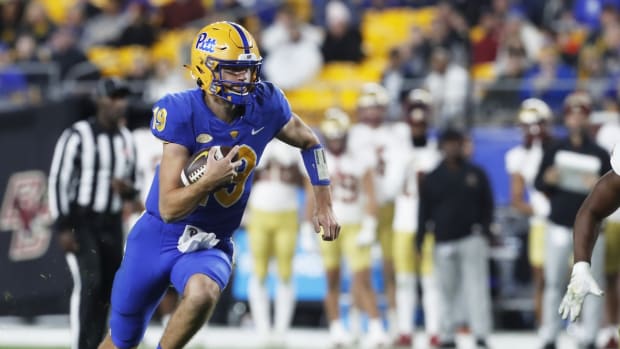Pitt Doesn't Need to Run For Sake of Running
PITTSBURGH -- All offseason, the tension between Pitt Panthers head coach Pat Narduzzi and former offensive coordinator Mark Whipple that went largely unnoticed while the team rolled to 11 wins and a conference title reared its head.
Narduzzi criticized Whipple, now the offensive coordinator at Nebraska for passing too frequently. He thought the Panthers could have taken advantage of teams in the run game, even though Whipple orchestrated the nation's No. 3 scoring offense.
“Our old offensive coordinator had no desire to run the ball,” Narduzzi said. “Everybody knew it. He was stubborn. Wake Forest was 118th in run defense, and we threw the ball every down. When we ran it, we ran it for 10 yards, but that wasn’t good enough.”
During spring practices and fall training camp, Pitt players and coaches have hammered home their desire to be more balanced and hone in more on running the ball. It made sense - the primary pieces of the passing offense had been shuffled over the offseason while the offensive line and running backs returned every major contributor.
But the early results of their renewed focus on running the football have not been as effective as imagined. Meanwhile, the passing offense has been productive and its come through in clutch moments for Pitt.
Starting quarterback Kedon Slovis was a perfect 5-5 passing on the game-tying drive against West Virginia. The following week against Tennessee, he completed 11 of 21 passes thrown beyond 10 yards. 166 of his 195 total passing yards - all of which came in the first half, before he exited with an undisclosed injury - came on throws beyond 10 yards as well.
Against West Virginia, the Panthers averaged just two yards per rush. Take out sack yardage which is unfairly counted against net rushing yards, and that figure is still less than four. The Tennessee game, boosted by a 76-yard touchdown sprint from Israel Abanikanda, featured a 3.6 yards per carry average.
Meanwhile, they averaged 12.8 yards on their 24 pass attempts. Of the 40 first downs Pitt has gained this year, 23 have come through the air compared to just 14 on the ground. Of the 30 plays that have gone for 10 or more yards through two games, 24 have come on pass completions.
This argument comes with some strings attached. Slovis needs to be healthy and the non-Jared Wayne wide receivers need to live up to their preseason hype. Obviously, if the Panthers need to roll with backup Nick Patti or third-stringers Nate Yarnell and Derek Kyler, they should look to ride a veteran offensive line and their deep tailback room, but the passing game has been too productive to ignore so far.
There will be a temptation to overpower opponents on the ground in the coming weeks with Western Michigan and Rhode Island rounding out the non-conference schedule before the Panthers ease into ACC play with Georgia Tech, Virginia Tech and Louisville first up, but the Panthers don't need to run for the sake of running because passing has been more effective, even against good competition.
Don't let pride or the manufacturing of some "gritty, blue-collar" image color your vision of this offense. If Pitt wants to score points and win, they should let it fly.
Make sure you bookmark Inside the Panthers for the latest news, exclusive interviews, recruiting coverage and so much more!
Former Pitt G Ashton Gibbs Joining Atlanta Hawks
Pitt Coaches Stick by Kicker after Rough Outing
Pitt Defense Focused on Run Against Western Michigan
Pitt's Starting QB vs. WMU Comes Down to Gametime Decision
Pitt Taking WMU Game Personally After Last Year's Loss
ACC Reveals Full Conference Schedule For Pitt Basketball
Pitt 'Unsettled' on Third QB to Replace Kedon Slovis, Nick Patti if Needed
- Follow Inside the Panthers on Twitter: @InsidePitt





